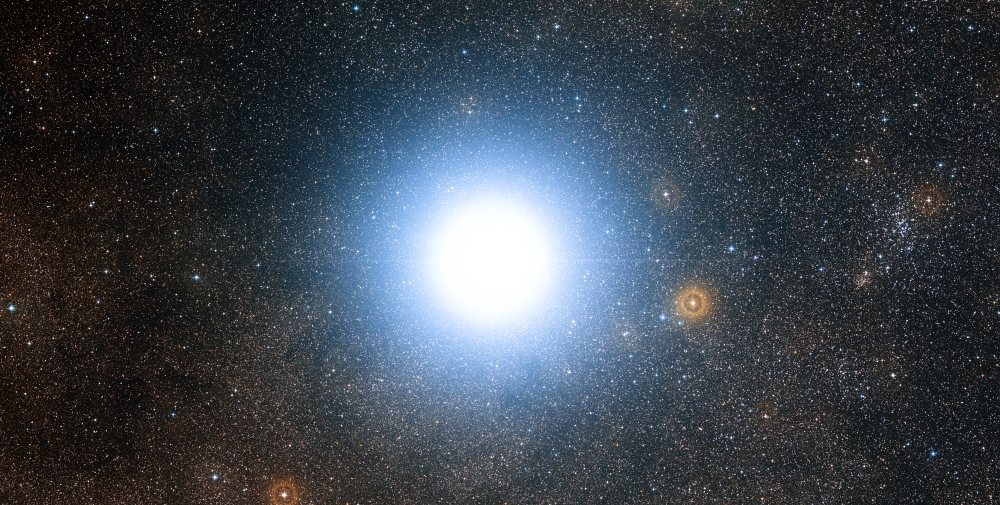
This wide-field view of the sky around the bright star Alpha Centauri was created from photographic images forming part of the Digitized Sky Survey 2. (European Southern Observatory)
Proposed Spacecraft Will Take 20 Years to Reach Alpha Centauri
Renowned physicist and cosmologist Stephen Hawking and Russian internet investor and physicist Yuri Milner recently announced an ambitious new project they hope will someday send thousands of tiny spacecraft to the stars to explore space and search for life in the universe.
Called ‘Breakthrough Starshot,’ the project plans to send gram-sized ‘nanocraft’ into deep space at a velocity of about one-fifth the speed of light.
The tiny spacecrafts would be driven by a powerful beam of light generated here on Earth. It would capture images and gather scientific data of possible planets in Alpha Centauri, the nearest star system, in just a little over 20 years after being launched.
Considering that the Alpha Centauri star system is 4.37 light years away from us, it would take nearly 30,000 years for today’s fastest spacecraft to reach the system.
Breakthrough Starshot is at a very early stage of development, but the plan is to launch the mini-probes to Alpha Centauri within the next generation.

This artist’s concept depicts the Bigelow Expandable Activity Module attached to the International Space Station’s Tranquility module. (Bigelow Aerospace)
NASA to Test First Expandable Habitat on ISS
NASA is continuing its preparations for future manned voyages to deep space destinations such as Mars.
One of the many issues they are addressing is the need for comfortable small areas for astronauts that doesn’t take much room in their spacecraft.
NASA will be trying out a new module that when fully deployed will expand its compressed size of about 2 meters in length and diameter to about 4 meters by 3 meters.
This new module is called the Bigelow Expandable Activity Module, or BEAM, scheduled for installation at the International Space Station on April 16th.
According to NASA the installation should take about four hours and will involve technicians from mission control in Houston and astronauts aboard the ISS.
Astronauts will first go into the module about a week after expansion and will occasionally return over its two-year test mission to retrieve data.

The 1917 photographic plate spectrum of van Maanen’s star from the Carnegie Observatories’ archive reveals first evidence of exoplanetary system. (Carnegie Institution for Science)
Photo Plate From 1917 Reveals First Evidence of Exoplanetary System
You’ve probably heard stories about someone digging through old storage boxes and finding a long lost treasure like a rare painting or photograph.
The folks at the Carnegie Observatories recently stumbled across something rare as they sifted through their archives to help a researcher.
The researcher was looking for photographic glass plate that contained spectral information of a white dwarf called van Maanen’s star.
Carnegie Observatories found the plate was produced in 1917, the year astronomer Adriaan van Maanen made his discovery.
Not only did the plate provide what the researcher was looking for, but it also shows the first-ever evidence of a planetary system beyond our own Sun.
While it has almost become common for distant worlds to be spotted, keep in mind that compared to 1917, astronomers today have access to much more sophisticated technology.
Six Steps to a Successful Apology
We all find ourselves in situations where we make a mistake, offend someone and find that owe them an apology.
A new study published in the journal Negotiation and Conflict Management Research finds that there are six elements that make up an apology that’s more likely to be accepted.
In order, here’s what they say you should do. First, acknowledge responsibility – admit the mistake is your fault. Then, off to fix what is wrong, in actions, not with words. Next, express regret, and then explain what went wrong. For the fifth element, declare your repentance – and last, request forgiveness.
Lead author of the study, Roy Lewicki, at Ohio State University’s Fisher College of Business, says apologies really do work, but you should try to include as many of the six elements as possible.
But if you’re in a hurry, Lewicki says that the first two elements, when you acknowledge responsibility, and offer a repair, are most important to having your apology accepted.
When apologizing face to face, he says that eye contact, and real sincerity, are also important.
























Comments are closed.